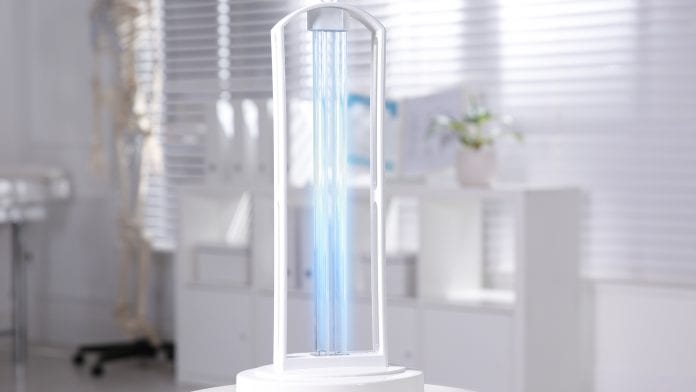
University of Siena Associate Professor of Public Health Gabriele Messina speaks with HEQ about innovation in UVC disinfection technology.
The past year has seen an explosion in the popularity of UVC radiation as a means of disinfecting air and surfaces, leading to a growing body of research into how to improve UVC technologies.
University of Siena Associate Professor of Public Health Gabriele Messina, whose research team has led the field in UVC chip technology, speaks with HEQ about innovation in UVC disinfection technology.
How does UVC disinfection work? What are the key benefits of disinfecting air and surfaces with UV light, as opposed to chemical cleaning methods?
UVC disinfection technology works by damaging the DNA of microorganisms, so that they either die or lose their ability to replicate. UVC radiation can be delivered by mercury lamps, LED or also, now, UVC chips; the optimum frequency of radiation to ensure that the radiation is adequately absorbed by the DNA of the microorganisms is around 264nm. UVC can be used to disinfect surfaces and air: UVC air disinfection is quite safe for the people using it, because UVC systems are architectured in such a way that there is no direct exposure to UVC sources; but when you use UVC to disinfect surfaces, you have to be aware that the effects of direct radiation on the skin and eyes can be damaging.
Because UVC disinfection is entirely physical, the development of resistance of microorganisms in human habitats is unlikely. In fact, there is no potential for microorganisms to develop resistance to it in the same way that they do to chemicals: over time, microorganisms can build a resistance to chemical disinfectants, because they are able to change rapidly to adapt to their surroundings. The example that I typically use when explaining the difference between UVC and chemical disinfection to students is that UVC radiation is similar to ‘burning’: regardless of a microorganism’s DNA makeup, if you burn it, it will die. With chemicals, because microorganisms can make those little changes, they can become less susceptible to the disinfectant over time; and then the microorganisms which are least affected by chemicals will thrive and build an increased level of resistance.
Chemical disinfectants are more complex to regulate, in part due to the multitude of ways chemical products can interact with each other. UVC is more direct and does not lead to these types of problems. In addition to this, UVC is definitely a greener approach in comparison to chemical disinfection, particularly when LEDs are used – traditional UVC lamps do still contain mercury, which is not particularly environment-friendly – but it is only a matter of time before those mercury lamps are entirely replaced by LEDs. Because of the pandemic, there are several devices already on the market which make use of UVC LEDs: there are still some barriers in place, such as high prices and the relatively low output power of these energy sources, but as these devices become more common they will increase in power and decrease in cost.
Are there any significant limitations or challenges associated with UVC disinfection?
There is no single perfect method for disinfection. It is always important to establish the correct context in which any technology should be used. For example, when UVC is used to disinfect surfaces, any areas which are in shadow will not be disinfected by the radiation; so it is necessary to place the sources of radiation in several locations in order to be sure to reach all the surfaces in the area. Another aspect which has to be carefully estimated is the fluid dynamic of the UV reactors, because that fluid dynamic is a key influence on the exposure of the air which passes through the reactor: it is important to make the right calculations to ensure that the appropriate dose is delivered through the reactor into the air, otherwise the desired effect will not take place.
How do UVC chips differ from other UVC disinfection devices? What benefits do they offer?
As I said before, there are different sources of UVC radiation: lamps, LEDs, and more recently, chips. We recently published a paper on the use of the new UVC chip technology: the chips are less powerful than LEDs, but the advantage of them is that they do not produce any heat. This means that they can be used to irradiate a target area at a very close proximity because there is no issue of overheating the target, which can be quite useful.
Whenever we talk about comparing the systems which use UVC, we need to talk about the correct dosage of radiation which is proposed for each system. Those doses are dependent on the radiant power of the sources, but also on the distance from the target: if a very powerful source of radiation is deployed over a very long distance, the target area will receive much less dose: in general, for a punctiform source the radiant power decreases with the square of the distance.
Meanwhile, if the distance can be significantly reduced, sources of light which are less powerful will be just as effective as the more powerful sources which are deployed over a longer distance. This is why it is important to make the right calculation to identify the dose which is actually able to reduce microbial contamination to the desired degree.
Sometimes with UVC LEDs the distance can be an issue because LEDs generate heat – less so than lamps, but still enough to cause problems with some specific applications, due to their limited power. With this in mind, chip technology can be quite useful simply because, even with a distance close to zero, it can perform effective disinfection in a very reasonable time, while not producing enough heat to be harmful to the target.
What are some potential future applications for UVC disinfection?
There are many applications which could benefit from the adoption of innovative sources of UVC radiation. The most common method of disinfecting air, surfaces or water using UVC is with mercury-based lamps, but there are several issues with these lamps: their dimensions can be unwieldy; they produce a lot of heat; they contain mercury, which is harmful; they consume a great deal of energy; they are not good in cases of physical shock; and each time they are turned on it incrementally decreases their lifespan.
However, this is now changing: we are seeing sources of UVC radiation with much lower energy consumption and with dimensions of only few millimetres, meaning that they can be placed anywhere. They can be battery-powered; they are less prone to both physical and thermal shock; they can be turned on and off thousands of times without affecting their overall lifespan; they can be placed in locations where the traditional lamps would not fit. This approach is really changing everything.
We started working with UVC LEDs 10 years ago. We then produced an innovative device, www.stetclean.com (awarded as the most innovative UV product in 2016 by the International Ultraviolet Association – IUVA), which is able to disinfect the stethoscope membrane in just a few minutes. Because of the small LED dimension, it is possible for a doctor to keep the device in the pocket of their coat, so it can disinfect the stethoscope membrane between uses. That was one of the first UVC LED disinfection devices introduced in healthcare, but nowadays we can see a lot of devices on the market which use UVC LEDs to disinfect phones or other small objects. The market is growing: there is a great deal of interest in UVC technologies and prices are dramatically reducing over time. Most new products are using LEDs as a source of UVC; and the use of UVC LEDs in disinfection is likely to increase even more over the next years.
Is there a need for additional or more targeted research in this field?
Yes, there is. At the moment, the efficiency of UVC LEDs is still quite low: only 4% of the energy consumed by LEDs goes towards generating UVC light; the rest is dissipated as heat, so more research is needed in this context to enable us to extract more UVC radiation from the LEDs. LED technology is more mature than the UVC chips, and it has already been demonstrated that this technology can be improved over time. There is still a big margin for improvement.
Many people are using UVC radiation for disinfection purposes, but UVC has to be used in the proper context for the safety of the user. There will not be a problem if the user remains well outside the scope of the radiation, but at the same time, there are devices for which this is not the case – for example, devices which deploy UVC radiation directly onto surfaces – and in these cases, we need to be sure that all the proper security measures have been taken into consideration. Many companies are using the pandemic as a trigger to launch their products into the market; but I would recommend relying on companies which have already been in the market for years, because they already know the advantages of UVC disinfection; they know its limits; and they know how to behave. Otherwise, you may risk working with someone who is not very skilled in the field – and that can be a problem.
Our team does a lot of tests on UVC products for companies which we trust. We do not just conduct lab tests in a controlled environment; in order to be sure that a technology will be useful it must be tested in a real-world context – people live in the real world, not in laboratories – so we conduct a lot of those tests to assess whether that technology can be beneficial to people in the real world. In addition, all engineering involved in these technologies must carefully consider multiple aspects related to safety and effectiveness, otherwise the system will not perform as expected. Any company which is looking at developing UVC technology will have to take into account the need to assess the related engineering protocols. However, the most important thing to remember is still that UVC systems must be designed in a proper way, by those who know how to use and test it.
Gabriele Messina
Associate Professor of Public Health
University of Siena
www.researchgate.net/profile/Gabriele-Messina-2
This article is from issue 18 of Health Europa. Click here to get your free subscription today.










